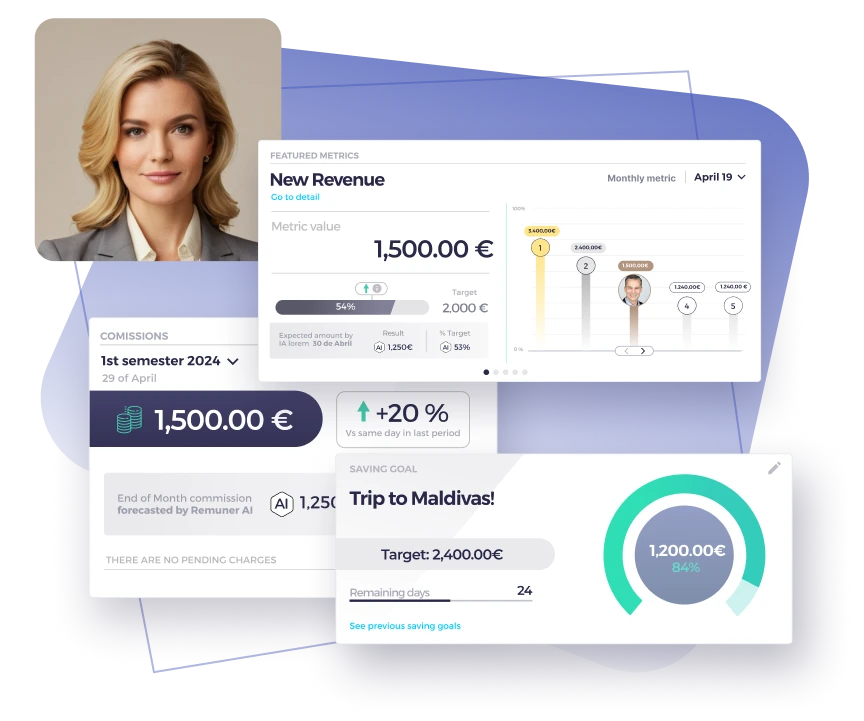Table of contents
A tiered commission structure is a sales compensation plan that enables sales reps to earn higher commissions on more revenue generated throughout the month. Unlike an entirely flat-rate commission, this ramps up the higher a sales rep goes beyond certain thresholds or “tiers.” It is a strategy that should match sales incentives with corporate goals, towards the end of coaxing reps to meet and surpass quotas as they take center stage in boosting overall income.
For some sales reps, closing a sale can be the difference between a good month and an average one.When it comes to big-ticket items or services, there is often more work involved in finding leads through prospecting calls (or managed inbound), negotiating prices that have fewer discounts / promotions factored-in on non-standard pricing arrangements.
How a tiered commission structure works
At its core, a tiered commission structure states that as sales reps make more money in revenue the higher their rates of commissions go. For example, the rep may get a 5% commission on $50K worth of product they sell. Maybe the commission now goes to 7% if they hit $100,000 in sales, or jumps up to 10% on anything over $150,000.
Here’s an example:
- Sales under $50,000: 5% Commission
- Sales from $50,001 to $100K: 7% commission
- Over $100,000 commission at 10%
This structure is particularly effective in driving sales motivation. Reps who are close to the next tier push harder to make additional sales, knowing they will earn a higher percentage. As a result, this model not only increases the number of deals closed but also boosts overall sales performance and helps teams consistently meet their quotas.
Tiered commission structures: the good and bad
Using a tiered commission structure can revolutionize the productivity of your sales team. Nonetheless, similar to any sales compensation model, it has its pros and cons. Companies need to factor on both side of the spectrum while designing suitable structures.
Pros:
- Compels reps to perform at their best: The lure of more money in commissions inspires salespeople to try and overachieve during the period. They can earn way more if they go to higher levels.
- Improves overall sales performance: This structure allows you to make the way sales goals are set align with corporate objectiveness. Reps are intrinsically motivated to hit their sales quota at first.
- Keeps top reps interested: High performers are able to keep the carrot on a string, so the best of your team stay invested and productive.
- Boosts positive competition: When other reps hit a higher tier, they inspire their colleagues to reach greater heights.
Cons:
- Potential burnout risk: The continuous push for higher ranks might result in overworking the sales reps with expectation to deliver more output than what they actually can.
- Ignoring smaller customers: Reps may raise the standard with their own high dollar deals but fail to see loyal-yet-downgradeable business that has been left behind.
- Management complexity: The more tiers you have, the harder to track and calculate commissions accurately without automation.
However, tools like Remuner can help to automate & simplify such complex compensation plans and thus managing tiered commission structure becomes easier.

Real-world examples of a tiered commission structure
Example 1: SaaS sales team
A software company selling a cloud-based solution sets up a tiered commission structure to motivate its sales reps. The goal is to drive more sales performance by incentivizing reps to close larger deals.
- Sales between $0 and $50,000: 4% commission
- Sales between $50,001 and $100,000: 6% commission
- Sales above $100,000: 8% commission
By pushing beyond their initial quota, reps are incentivized to hit higher revenue targets, resulting in increased earnings for both the rep and the company.
Example 2: Real estate agents
A real estate firm implements a tiered commission plan for property sales, where higher-value properties earn agents increased commission rates:
- Sales up to $500,000: 3% commission
- Sales between $500,001 and $1,000,000: 5% commission
- Sales over $1,000,000: 7% commission
This plan aligns agent incentives with the firm’s goal of closing higher-value properties. The company encourages agents to sell more expensive properties to maximize their commissions.
Designing a successful tiered commission structure
The bottom line on how to make a tiered commission structure work The design will need to support the revenue goals of a company, and have the delicate art of rewarding top performers without shoe-horning reps into closing these massive deals.
What it does provide is a framework you can use if you want to put together your own tiered commission structure in an efficient way.
1. Set quotas as firmly and strictly
Create a QUOTA that is both unrealistic yet possible using real figures. These quotas must align with how individuals and companies score for sales.
2. Create attainable commission tiers
Make the tiers such that reps only need to take a step or two up in order for them to get to tier. Growing up too much between the tiers can demotivate your reps, but growing up to little may not push them enough.
3. Include OTE
Ensure that On-Target Earnings (OTE) are realistically aligned with the top tier of the plan. This motivates sales reps to exceed their expected performance, driving overall sales.
4. Reward over-achievement
Reps who over-perform should be rewarded generously. Tiers should offer significant enough incentives to push reps to close more deals.
5. Maintain transparency
Sales teams need visibility into their performance and commission plans. Real-time dashboards, like those offered by Remuner, allow reps to track their progress and commission earnings.
How tiered commission structures drive sales performance
A tiered commission structure is one of the most effective ways to increase sales motivation. Reps who understand that each additional sale moves them closer to a higher commission rate are naturally driven to close more deals. This system ensures that both top performers and mid-level reps are incentivized to push themselves beyond their typical limits.
Unlike traditional compensation models, where sales reps may plateau after hitting their quota, a tiered commission structure encourages continuous growth. Even after hitting their base-level targets, reps are still motivated to continue closing deals to reach the next tier. This ultimately leads to more closed deals, higher customer satisfaction, and an overall improvement in sales performance.
Design a tiered commission structure to maximize performance
A well-designed tiered commission structure can significantly boost a company’s sales performance. By aligning sales incentives with company goals and offering progressively higher commission rates, companies can ensure that sales reps are motivated to exceed their quotas.
When designing this structure, it’s crucial to keep in mind the pros and cons. By setting clear tiers and offering visibility into performance, companies can foster a sales culture where everyone strives to overachieve. As a result, you’ll see more deals closed, improved customer satisfaction, and a stronger sales team overall.
Start creating your compensation plans with Remuner
Remuner simplifies managing complex compensation plans like tiered commission structures. With our platform, you can design and automate any commission model without the operational burden. Sales teams get real-time visibility into their performance, motivating them to reach higher tiers and exceed their goals. Our AI-driven insights help managers fine-tune plans to maximize results, ensuring alignment with company objectives. Whether you’re looking to motivate reps or streamline compensation processes, Remuner provides the tools to boost your team’s performance effortlessly.





